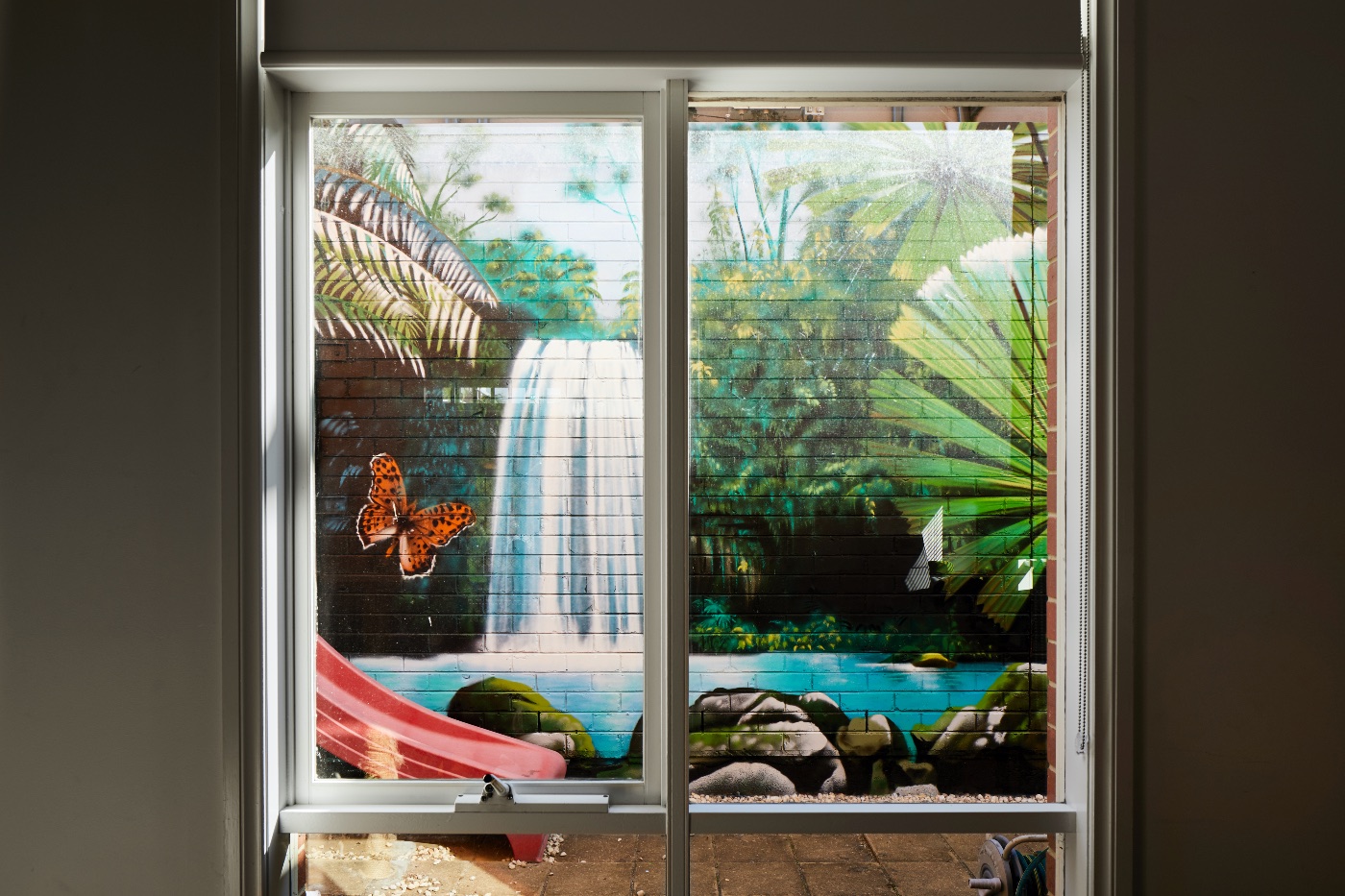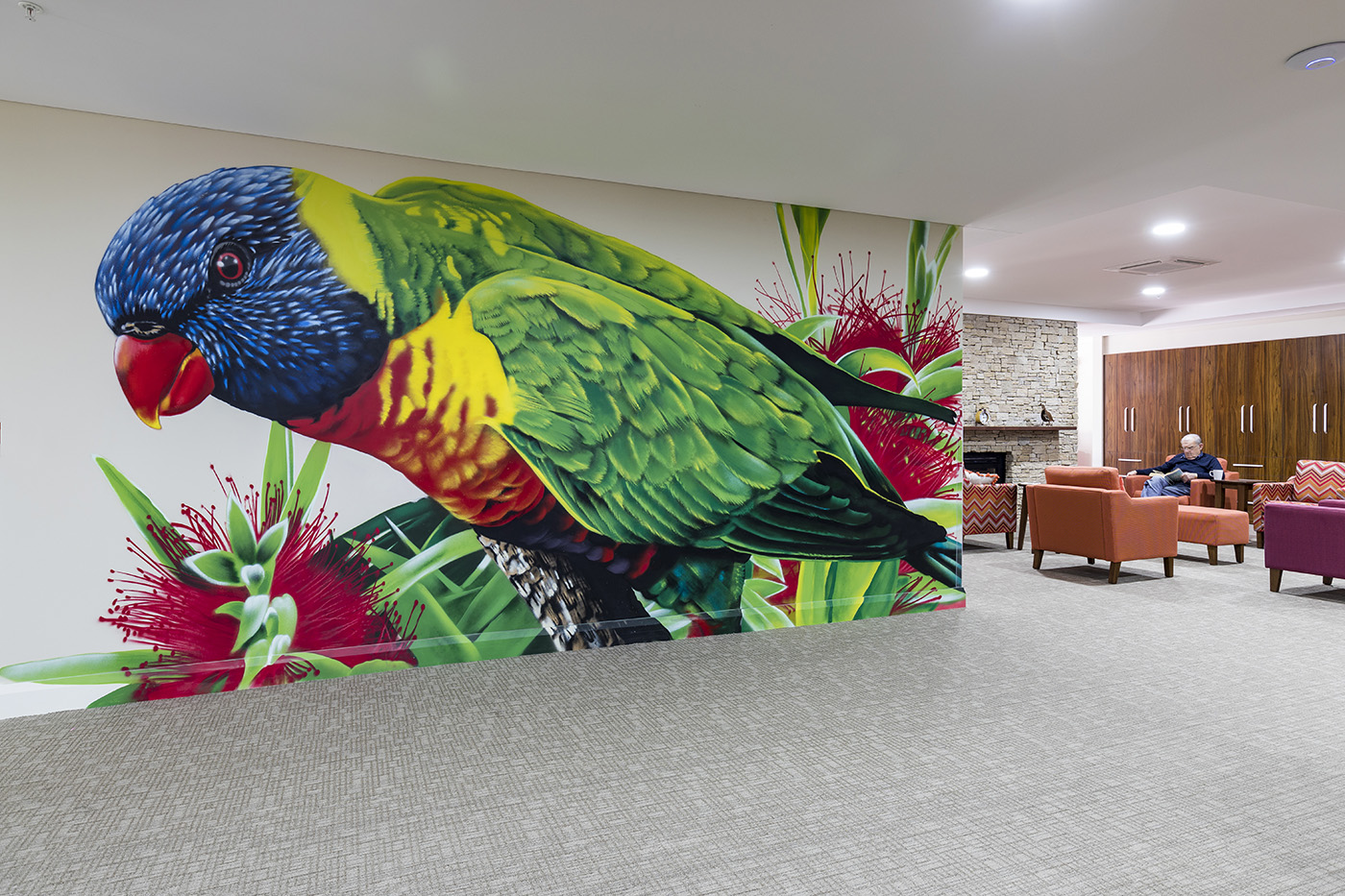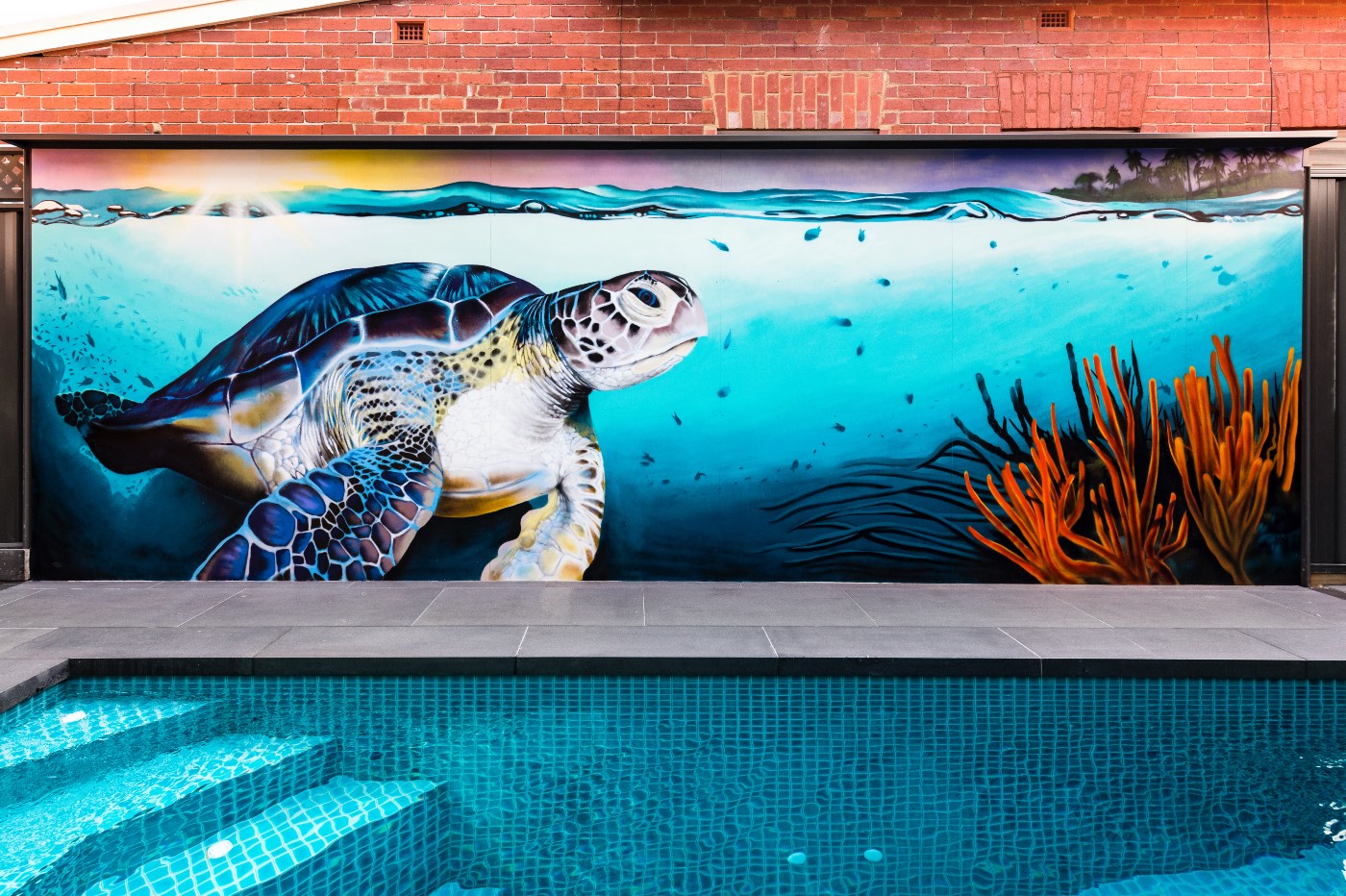Graffiti & Architecture
Graffiti murals that complement interior design and architecture
Over the last few years, we have been getting more and more commissions to paint graffiti murals that compliment architecture. Murals such as sweeping rainforest backdrops that surround a pool, or wildlife scenes that bring a space to life. As this is becoming more popular, we thought we would explore some of the common questions we get asked when someone thinks about splashing down a mural on that crisp flat wall in their home, office or back yard.
Can a graffiti mural increase or decrease your property value?
Getting a large scale mural painted on a 10m x 3m wall will cost between $9-10k, so that cost alone ads value right there. Although the actual value of turning a blank drab wall into a vast wilderness, a beautiful pattern or a street scene of the local area is hard to measure.
It is hard to put a price on something completely unique such as a forest-themed mural or beach scene that transports the viewer into another location, making them feel cool or hot, happy or excited just by looking at it. Artwork such as a Melbourne or Sydney street scene provides sentimental value, generating a sense of nostalgia for owners and prospective buyers.
A mural will never decrease the value of a property as it can be easily painted over. However, a beautiful piece of art that is entirely unique can significantly add to the value of a property.

How can street art murals change a space?
We have all heard that if you paint your room white it will feel larger. White reflects light making it brighter and hence feels bigger. The same colour theory applies to a mural, but the effect is enhanced by the subject matter and the ability to create illusions with 3D.
Mural artworks can make a room feel cooler, warmer or brighter or even create depth to make a space appear larger. The vibrant colours and energetic forms of graffiti can also change the energy of a space, making it feel more alive, as if it is moving.
Most street art and graffiti is done outdoors, so when you bring this style of art into an indoor space, you get that crazy juxtaposition of outside being inside, kind of like how raw brick can make a space feel. At its essence, art sets the tone of a space, the style and content of the art can create a wide variety of tones depending on the brief. The brief usually comes from the client, but careful collaboration between artist and architect is always important to ensure the artwork complements the architectural lines of a space. Artist's should also collaborate with interior architects and designers to ensure colour palettes are working and decor is complemented.

How do you make a space feel bigger?
To make a space feel bigger the artwork needs to have depth. Images of sunsets, long city streets or dense jungles create a sense of distance as you look into them, subconsciously making you feel you are in a large open space.
Artwork can also make a space feel smaller if it is too dark or cluttered or using too much of the wall space. Choosing the right artist and concept will help you to achieve the right result. Designing the artwork to-scale, in colour and showing how the artwork looks in a space with mock-ups gives clients a good idea of how the finished product will turn out. Any issues can be sorted in the design phase, after the artwork is completed it is hard and sometimes expensive to make changes.
How much should you expect to pay to add a mural to a property?
The cost of a mural depends on the artist, the size and the complexity of the concept. The experience of the artists will also influence the cost.
The longer an artist has been honing their skill, the more you should expect to pay. Street Artists who have painted murals for many years will know what will work for a space and what won't. Their technique will be more refined and the use of materials more considered.
Generally, artists charge a day rate and allocate time to create the artwork, but some cost their artworks based off different parameters like how prominent the wall space is or difficult the brief is to interpret. Artists new to the mural game might charge a few hundred dollars a day, whereas more experienced artists can charge up to $5k a day.
Experienced artists will create a design concept that the client can review and provide feedback on, ensuring they know what the finished product will look like and there are no surprises. Design concepts will be charged for.
For a great piece of art, 2.7m high (standard ceiling height) by 6m long, the price will generally be between $5-8k.

What surfaces can a graffiti mural be painted on?
Murals can be painted on any flat surface. A lot of spray paint artists will paint corrugated surfaces, and even rough timber can be painted. But if painting directly onto a wall is not an option, then consider the following:
- Canvas artwork framed or unframed. Canvas needs to be stretched, so it isn't always a good option for big spaces as the canvas needs to get through doors. Canvas can be painted off a roll, though, and this can be easily bought in at large sizes and can be stretched in the space to avoid access problems.
- Timber panelling is a good option, as timber panels come in sizes as big as 2.4m x 1.2m which can be fixed to a wall to create large-sized artboards. These can be painted on or off-site and then fixed to a wall.
- Vinyl decal is another option, either using digital artwork or laid upon a wall so the artists can paint directly onto the decal.
How long does a graffiti mural take to paint?
This question is hard to answer as the following factors need to be considered:
- The speed the artist traditionally works at
- The complexity of the design
- The number of colours required
- The size of the space
Graffiti artists will often cost the mural based on how long it will take to paint, factoring in the above points. Always ask an artist for a quote and a timeline.

Can the street artist work with the architect?
This depends on whether the architect is the creative director for the project or the client. When an artist gets engaged by an architect, it is a good idea to get the client involved from the outset.
The client and the architect will have their own vision that will need to be agreed upon for the space. The client needs to take advice from the architect when bringing an artist on board. The artists will most likely need to work with the architect or the builder to get measurements and schedule access to the site.
What is the process of getting a mural painted?
The process of commissioning a mural to be painted is:
- Research artists online and find one who paints the styles you like or has extensive experience working across all styles. Instagram and google are the best places to find artists.
- Once you have chosen an artist, make contact and ask them about their work process and what is required to get a quote. Artists will usually ask you for a picture of the artwork space, some measurements, and any creative direction that the client wants to add.
- The artist will come back with a process and quote for the project. This is the point where you decide to proceed or not.
- Artists usually ask for a 50% deposit for the project.
- Artists will need time to design the artwork and get sign-off from the client/architect before commencing the mural.
- The artist will need time to acquire materials, equipment, make final design changes and organise access. It is unsafe for artists to paint above 3m without appropriate access equipment.
- Then they come and paint.
You can read more about our process here.
It is always recommended that you ask to see an artist's previous works to determine if they have completed similar projects in the past. Confirm that the artist is insured for public liability, and in some instances WorkCover may also be required.


Our Services
- MuralsGraffiti and street art murals for anywhere - hospitality, office, residential...01
- Brand ActivationsBranded live graffiti for product launches & brand activations. 02
- EventsLive artwork production by graffiti and street artists for events.03
- Removable ArtStreet art and graffiti prints, canvases and wallpaper.04
- DesignLogos, rebranding, graffiti and street art graphic design for print and digital.05
- WorkshopsLearn to paint with a spray can via a graffiti workshop experience.06
- Content CreationFilm a mural being painted and share the content on socials.07
- MaintenanceCare and upkeep of outdoor and indoor graffiti and street art murals.08
Read more about our services. Learn about our process.


